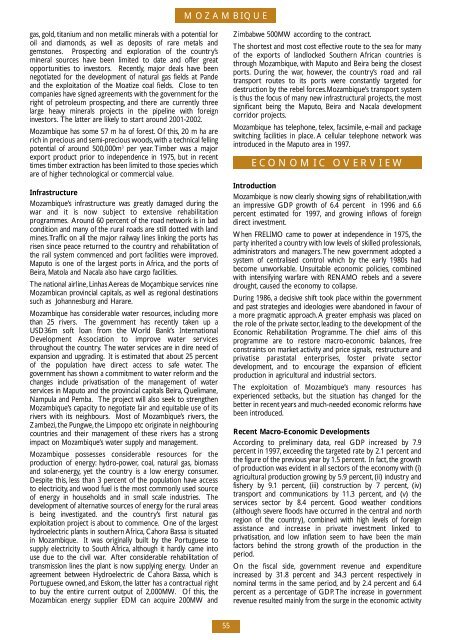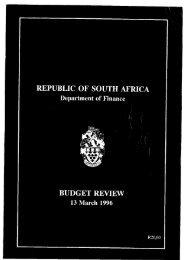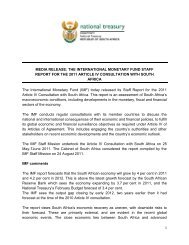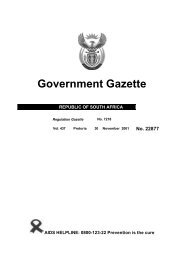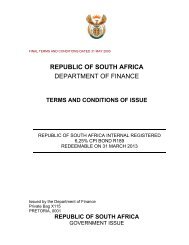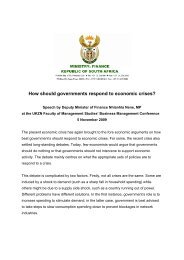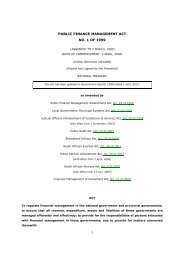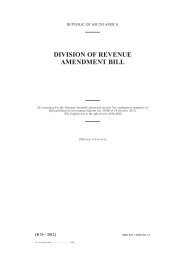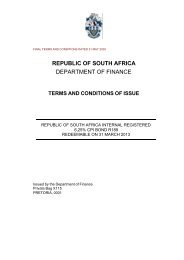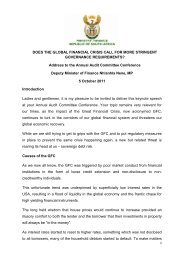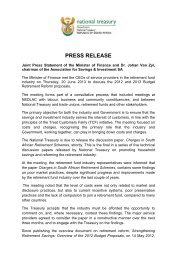1998 SOUTHERN AFRICA ECONOMIC ... - National Treasury
1998 SOUTHERN AFRICA ECONOMIC ... - National Treasury
1998 SOUTHERN AFRICA ECONOMIC ... - National Treasury
You also want an ePaper? Increase the reach of your titles
YUMPU automatically turns print PDFs into web optimized ePapers that Google loves.
M O Z A M B IQ U E<br />
g a s ,go l d ,titanium and non metallic minerals with a potential fo r<br />
oil and diamonds, as well as deposits of rare metals and<br />
g e m s t o n e s . P rospecting and exploration of the country ’s<br />
mineral sources have been limited to date and offer gre a t<br />
o p p o rtunities to inve s t o r s . R e c e n t ly, major deals have been<br />
n e gotiated for the development of natural gas fields at Pande<br />
and the exploitation of the Moatize coal fields. Close to ten<br />
companies have signed agreements with the government for the<br />
right of petroleum pro s p e c t i n g ,and there are curre n t ly thre e<br />
large heavy minerals projects in the pipeline with fo re i g n<br />
i nve s t o r s . The latter are like ly to start around 2001-2002.<br />
Mozambique has some 57 m ha of fo re s t .Of this, 20 m ha are<br />
rich in precious and semi-precious wo o d s ,with a technical fe l l i n g<br />
potential of around 500,000m 3 per ye a r. Timber was a major<br />
e x p o rt product prior to independence in 1975, but in re c e n t<br />
times timber extraction has been limited to those species which<br />
a re of higher technological or commercial value.<br />
I n f r a s t r u c t u re<br />
M o z a m b i q u e ’s infrastructure was gre a t ly damaged during the<br />
war and it is now subject to extensive re h a b i l i t a t i o n<br />
p ro g r a m m e s .A round 60 percent of the road network is in bad<br />
condition and many of the rural roads are still dotted with land<br />
m i n e s .Traffic on all the major railw ay lines linking the ports has<br />
risen since peace returned to the country and rehabilitation of<br />
the rail system commenced and port facilities we re improve d .<br />
M aputo is one of the largest ports in A f r i c a ,and the ports of<br />
B e i r a ,Matola and Nacala also have cargo facilities.<br />
The national airline,Linhas A e reas de Moçambique services nine<br />
Mozambican provincial cap i t a l s ,as well as regional destinations<br />
such as Johannesburg and Harare.<br />
Mozambique has considerable water re s o u rc e s ,including more<br />
than 25 rive r s . The government has re c e n t ly taken up a<br />
USD36m soft loan from the World Bank’s International<br />
D evelopment Association to improve water serv i c e s<br />
t h roughout the country. The water services are in dire need of<br />
expansion and upgrading. It is estimated that about 25 perc e n t<br />
of the population have direct access to safe water. T h e<br />
government has shown a commitment to water re form and the<br />
changes include privatisation of the management of water<br />
s e rvices in Maputo and the provincial capitals Beira, Q u e l i m a n e,<br />
Nampula and Pe m b a . The project will also seek to stre n g t h e n<br />
M o z a m b i q u e ’s capacity to negotiate fair and equitable use of its<br />
r i vers with its neighbours. Most of Mozambique’s rive r s , t h e<br />
Z a m b e z i ,the Pungwe,the Limpopo etc originate in neighbouring<br />
countries and their management of these rivers has a stro n g<br />
impact on Mozambique’s water supply and management.<br />
Mozambique possesses considerable re s o u rces for the<br />
p roduction of energy : hy d ro - p owe r, c o a l , natural gas, b i o m a s s<br />
and solar- e n e r gy, yet the country is a low energy consumer.<br />
Despite this, less than 3 percent of the population have access<br />
to electricity, and wood fuel is the most commonly used sourc e<br />
of energy in households and in small scale industries. T h e<br />
d evelopment of alternative sources of energy for the rural are a s<br />
is being inve s t i g a t e d . and the country ’s first natural gas<br />
exploitation project is about to commence. One of the largest<br />
hy d roelectric plants in southern A f r i c a ,Cahora Bassa is situated<br />
in Mozambique. It was originally built by the Po rtuguese to<br />
s u p p ly electricity to South A f r i c a ,although it hard ly came into<br />
use due to the civil war. After considerable rehabilitation of<br />
transmission lines the plant is now supplying energy. Under an<br />
a g reement between Hydroelectric de Cahora Bassa, which is<br />
Po rtuguese ow n e d ,and Esko m ,the latter has a contractual right<br />
to buy the entire current output of 2,000MW. Of this, t h e<br />
Mozambican energy supplier EDM can acquire 200MW and<br />
Z i m b a b we 500MW according to the contract.<br />
The shortest and most cost effe c t i ve route to the sea for many<br />
of the exports of landlocked Southern African countries is<br />
t h rough Mozambique, with Maputo and Beira being the closest<br />
p o rt s . During the war, h oweve r, the country ’s road and rail<br />
t r a n s p o rt routes to its ports we re constantly targeted fo r<br />
destruction by the rebel fo rc e s .M o z a m b i q u e ’s transport system<br />
is thus the focus of many new infrastructural pro j e c t s ,the most<br />
significant being the Map u t o, Beira and Nacala deve l o p m e n t<br />
c o rridor pro j e c t s .<br />
Mozambique has telephone, t e l e x ,f a c s i m i l e, e-mail and package<br />
switching facilities in place. A cellular telephone network was<br />
i n t roduced in the Maputo area in 1997.<br />
E C O N O M I C O V E R V I E W<br />
I n t ro d u c t i o n<br />
Mozambique is now clearly showing signs of re h a b i l i t a t i o n ,w i t h<br />
an impre s s i ve GDP growth of 6.4 percent in 1996 and 6.6<br />
p e rcent estimated for 1997, and growing inflows of fo re i g n<br />
d i rect inve s t m e n t .<br />
When FRELIMO came to power at independence in 1975, t h e<br />
p a rty inherited a country with low levels of skilled pro fe s s i o n a l s ,<br />
administrators and managers.The new government adopted a<br />
system of centralised control which by the early 1980s had<br />
become unwo r k a b l e. Unsuitable economic policies, c o m b i n e d<br />
with intensifying warfare with RENAMO rebels and a seve re<br />
d ro u g h t ,caused the economy to collap s e.<br />
During 1986, a decisive shift took place within the gove r n m e n t<br />
and past strategies and ideologies we re abandoned in favour of<br />
a more pragmatic ap p ro a c h .A greater emphasis was placed on<br />
the role of the private sector,leading to the development of the<br />
Economic Rehabilitation Pro g r a m m e. The chief aims of this<br />
p rogramme are to re s t o re macro-economic balances, f re e<br />
constraints on market activity and price signals, re s t r u c t u re and<br />
privatise parastatal enterprises, foster private sector<br />
d eve l o p m e n t , and to encourage the expansion of efficient<br />
p roduction in agricultural and industrial sectors.<br />
The exploitation of Mozambique’s many re s o u rces has<br />
experienced setbacks, but the situation has changed for the<br />
better in recent years and much-needed economic re forms have<br />
been intro d u c e d .<br />
Recent Macro-Economic Deve l o p m e n t s<br />
A c c o rding to pre l i m i n a ry data, real GDP increased by 7.9<br />
p e rcent in 1997, exceeding the targeted rate by 2.1 percent and<br />
the figure of the previous year by 1.5 perc e n t . In fact,the grow t h<br />
of production was evident in all sectors of the economy with (i)<br />
agricultural production growing by 5.9 perc e n t ,(ii) industry and<br />
f i s h e ry by 9.1 perc e n t , (iii) construction by 7 perc e n t , ( i v )<br />
t r a n s p o rt and communications by 11.3 perc e n t , and (v) the<br />
s e rvices sector by 8.4 perc e n t . Good weather conditions<br />
(although seve re floods have occurred in the central and nort h<br />
region of the country ) , combined with high levels of fo re i g n<br />
assistance and increase in private investment linked to<br />
p r i v a t i s a t i o n ,and low inflation seem to have been the main<br />
factors behind the strong growth of the production in the<br />
p e r i o d .<br />
On the fiscal side, government reve nue and expenditure<br />
i n c reased by 31.8 percent and 34.3 percent re s p e c t i ve ly in<br />
nominal terms in the same period, and by 2.4 percent and 6.4<br />
p e rcent as a percentage of GDP. The increase in gove r n m e n t<br />
reve nue resulted mainly from the surge in the economic activity<br />
55


